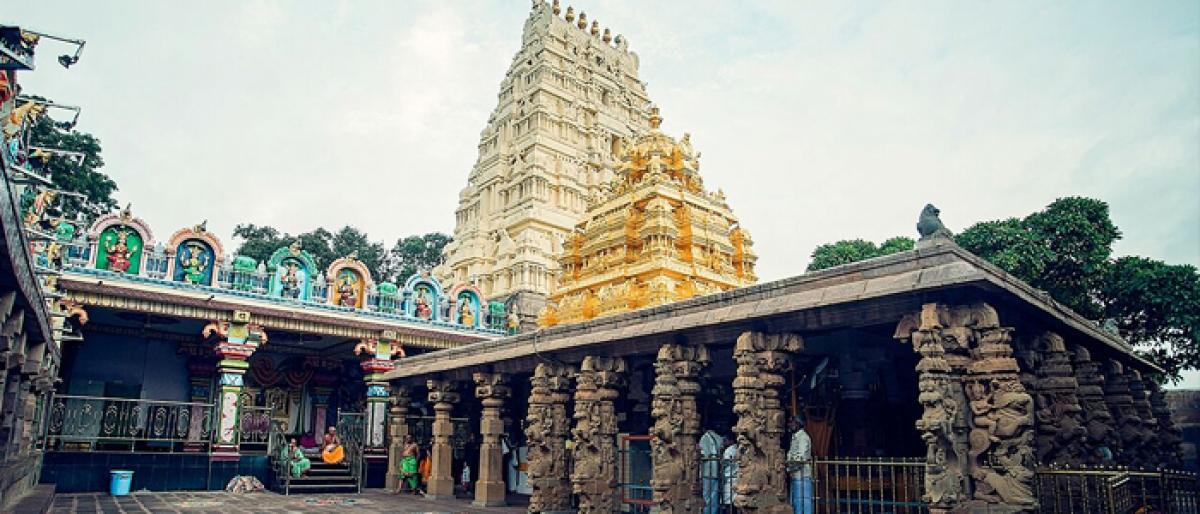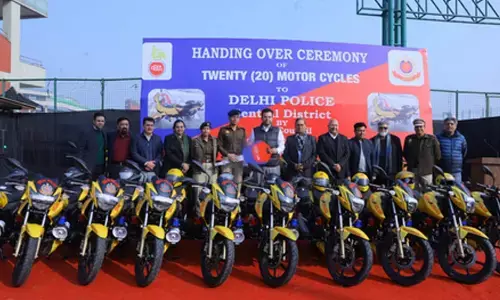The Benevolent Mother Goddess

One hundred and eight Actually, just fifty one or perhaps fifty two Only eighteen These are the various versions regarding the number of Shaktipeethams in the Indian subcontinent
One hundred and eight. Actually, just fifty one or perhaps fifty-two. Only eighteen. These are the various versions regarding the number of Shaktipeethams in the Indian subcontinent.
The Shaktipeethams are important and significant temples where the Mother Goddess is worshipped in the Hindu tradition. These seats of the goddess Durga, spouse of god Shiva, are considered immensely powerful centres of divine energy. For many devout Hindus, these shrines are must-visit places. They are spread over India, Bangladesh, Tibet, Nepal, Pakistan and Sri Lanka going by the various versions.
The story surrounding the Shaktippethams and how they came into existence also has several versions. However, broadly speaking, this is the gist of all the stories. After the terrible Daksha Yagnam which had a tragic end, Shiva carried the body of his wife Sati aka Dakshayani, who was born as the daughter of Daksha in that avatar. He roamed the l4 worlds with it. He even performed the Tandavam (the Shiva Tandavam is the celestial dance of Shiva) in the grip of intense emotion.
The body was cut into 52 or (51) body parts, by the Sudarshana Chakra, the weapon of Vishnu and all of them fell on earth with each place becoming a sacred site for worship of the Mother Goddess or Durga. In each place, she came to be known by a different name. Since she is the spouse of Shiva, and Indian temples believe in the worship of a deity along with the spouse, Shiva too is worshipped at these temples where he sometimes takes the form of Bhairava.
This story is told and retold in many Puranas and religious books which are centuries old. It is also the subject of many lyrics in Indian music. Solo items or entire dance-dramas performed in several Indian classical dance forms also narrate this story. I have seen that this story also finds expression in plays in different languages.
I have often seen episodes from this story and sometimes, the whole story, performed in Kuchipudi and Bharatanatyam as also in Kathakali. The reasons are not hard to understand. Indian classical dance forms draw heavily on stories from the epics and Puranas. Moreover, this story of Shiva and Shakti contains high drama and intense emotions and is amenable to dramatic presentation in dance as well as in theatre.
Religious historians and scholars give reasons for the differing numbers. It is said that there are actually 108 but since some are marked as major and the others are minor, this is how the number 52 came about. Also, the number 51 is said to correspond to the 51 alphabets in Sanskrit. Finally, there is the revered saint and composer Adi Shankaracharya, a great worshipper of Shiva and Shakti.
He is also believed to have been born with their divine energy and power, and thus a part or amsham of them. He wrote exquisite Sanskrit verses on these deities. In one of his stotrams, he describes 18 Shaktipeethams so many believe this number is authentic. These are called Ashtadasha Shaktipeethas. The word Ashtadasha is Sanskrit for the number 18.
I have frequently heard the chant of this Ashtadasha Shaktipeetha stotram by priests in the four major Peethams or Advaita monasteries established by Adi Shankaracharya during his lifetime (around 800 A.D.). I have also seen it inscribed on the walls of a few Devi temples in the interiors of Karnataka, Tamil Nadu and Andhra Pradesh. It goes thus and promises many boons like good health, wealth and conquest of enemies to the believer who chants it regularly.
Lankayam Shankari Devi,
Kamakshi Kanchika Pure
Pradyumne Shrinkhala Devi,
Chamunde Krouncha Pattane
Alampure Jogulamba, Shrishaile Bhramarambika
Kolhapure Mahalakshmi, Mahurye Ekaveerika
Ujjainyam Mahakali, Peethikayam Puruhuthika
Odhyane Girija Devi, Manikya Daksha Vatike
Harikshetre Kaamaroopi, Prayage Madhaveshwari
Jwalayam Vaishnavi Devi,
Gaya Mangalya Gaurika
Varanasyam Vishalakshi,
Kashmire Thu Saraswathi
Ashtadasha Shaktipeethani,
Yoginamapi Durlabham
Sayamkaale Pathennithyam,
Sarvashatru Vinashanam
Sarvaroga Haram Divyam,
Sarva Sampatkaram Shubham.
From this we deduce that the different shrines to Shakti include Varanasi, Alampur (Telangana), Srisailam (Andhra Pradesh), Kolhapur (Maharashtra), Ujjain (Madhya Pradesh), Gaya (in Uttar Pradesh), Kanchipuram (Tamil Nadu), Kashmir, Sri Lanka, etc.. This also reveals that she is known by a different name in each place. Like the name Vishalakshi in Varanasi, Mahankali in Ujjain, Jogulamba in Alampur, Mahalakshmi in Kolhapur, Kamakshi in Kanchipuram, Saraswathi in Kashmir and so on.
Whichever version a person believes is entirely his or her personal choice. Hinduism allows many belief systems to co-exist and declares that God is one but the paths leading to Him are many. So, going by that, all versions have some authenticity.
There are many books of old which regard four Shaktipeethams as the greatest and these are referred to as the four Adi Shakti Peethams. They are said to the original and most powerful ones centres of female energy. This is the theory for which the Devi Bhagavatham and Shiva Purana are the sources according to several religious leaders. So, the four Adi Shakti Peethams are Pada Bimala Shaktipeeth located in Puri, Orissa; Kalighat Kali Temple Kalighat, Kolkata; Kamarupa or Kamakhya Temple situated on the Nilachal Hill in Guwahati, Assam; Tara Tarini Sthana Peeth situated on the Taratarini hill, Orissa.
Among all these temples in the several versions above, the Mallikarjuna--Bhramarambika temple at Srisailam in Andhra Pradesh has a special place. This is because it is the only temple anywhere which is both a Shaktipeetham and a Jyotirlinga kshetra. The Jyotirlinga kshetras are the most venerated Shiva temples in India and celebrated as places with a deep spiritual significance.
There is a legend behind this Jyotirlinga listing too of Shiva shrines as it is with the Shaktipeethams but that is another story. As a frequent visitor to Srisailam from childhood, I have always been fascinated not only by the story of Bhramarambika--which means the Bee Goddess-- but also the legend that one can hear the sound of bees buzzing behind the sanctum-sanctorum if one listens carefully.
Here is where I have found many books being sold not only on the kshetra mahima or the miracles attributed to the place as also books containing legends about the Shaktipeethams. Over the years, I have watched the temple and the region grow in many ways. The once highly forested region is now less green and has also morphed into a big popular tourist attraction with boating, cable cars and children's parks. Its proximity to the mammoth Nagarjunasagar have all turned this region into a huge draw for the devout and the touristy types alike.
The best thing about Srisailam? The totally democratic or socialist nature of the temple---there are no restrictions on who can enter the temple and perform puja in the sanctum. A simple dress-code and faith are the only conditions for entry. I visited the Kalighat Kali temple a few times during my long stay in Kolkata. I have found this idol the most fierce-looking among all the Shaktipeetham temples. Fiery-looking eyes, a long, protruding tongue and a weapon in hand give her the appearance of a goddess fiercely intent on protecting her children from evil forces. A more benign version of Kali is seen in Dakshineshwar, on the city's outskirts.
Many people who visit Orissa do the usual Puri, Lingaraja and Konarak visits but not all will visit the two Shaktipeethams in the state because they are lesser-known than the former famous temples. Aware of the legends, my parents took me to visit these two shrines also and I have hazy memories of the pilgrimages.
Varanasi, celebrated as the world's oldest living city is home to India's most revered Shiva temple, the Kashi Vishweshwara. Since his spouse is Vishalakshi mentioned in the Shaktipeetham list, the temple draws the devout and curious alike from around the world. I have learnt not to mind the dirt and chaos surrounding the temple area as also the importunate beggars when visiting this holiest of holies for Shiva devotees. It is worth enduring all that to be able to visit this great temple. This city is also considered to be the most photographed and written-about pilgrim sites in India.
The Mother Goddess is visualised wonderfully as a yogini or yoga-practitioner in the famous Jogulamba temple at Alampur, Telangana. This Shaktipeetham is also significant because of the cluster of Navabrahma temples one finds here. Like so many visitors, I was fascinated by the architectural beauty of this place and also sorry to learn how much of it had been destroyed by marauding invaders and had to be rebuilt as best as possible. Whether it is because of the remote location and lack of crowds on weekdays, or the sheer spiritual ambience of a place where the deity is associated with yoga and meditation, or all of them together, I found this to be among the most serene of the Shaktipeethams.
As for Kanchipuram, the idol of the goddess Kamakshi is exquisitely beautiful and there is hardly any devout south-Indian who has not been there, or at least dreams of going there. Visitors to the large and bustling Kanchi Math nearby also flock to this temple. Many devotees, and I confess I am one of them, are also drawn to this famous temple town for reasons other than spiritual ones. These are shopping opportunities for gorgeous Kanjivaram sarees and the great food especially the eponymous idlis that this famous temple town offers.







